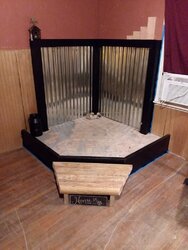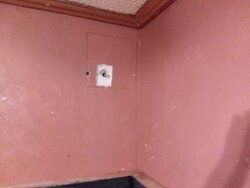Hi my name is Den i live in erin tn i just bought a salvaged home and discovered the heat unit is shot..can someone guide me as to who sells the best and cheapest wall thimbles? And guide me into hooking up these hand me down wood stoves? Im new to all this and could sure use help...im trying to get these 2 wood stoves in before winter hits tennessee...thanks guys!>
Need help from wood stove folks
- Thread starter Bikerguyforlife
- Start date
-
Active since 1995, Hearth.com is THE place on the internet for free information and advice about wood stoves, pellet stoves and other energy saving equipment.
We strive to provide opinions, articles, discussions and history related to Hearth Products and in a more general sense, energy issues.
We promote the EFFICIENT, RESPONSIBLE, CLEAN and SAFE use of all fuels, whether renewable or fossil.
You are using an out of date browser. It may not display this or other websites correctly.
You should upgrade or use an alternative browser.
You should upgrade or use an alternative browser.
You might want to slow down a bit. Different stoves have different r ratings for the hearth as well as clearance to combustibles. Consider getting the stove(s) first.
Blazingembers7749
Member
AgreedYou might want to slow down a bit. Different stoves have different r ratings for the hearth as well as clearance to combustibles. Consider getting the stove(s) first.
I have the stoves..one is an old atlantic 224 and also a vermont resolute..the resolure however has very small log length 13" i thinkAgreed
If u haven't already done so, check out the install manuals for each. Make sure you meet or exceed the requirements.
Does anyone know the cheapest place to buy stove pipe online? I also need to wall thimbles...no codes here in tn but would like to do it safe...is it required to have double wall going outside? Its quite expensive any insight would be goodIf u haven't already done so, check out the install manuals for each. Make sure you meet or exceed the requirements.
Blazingembers7749
Member
Blazingembers7749
Member
i just ordered 2 of the Selkirk Corp 206463 6,...could sure use help when i get them...lol cutting into my vinyl siding is scareyWhere possible i like using the insulated wall thimbles
Blazingembers7749
Member
Blazingembers7749
Member
Thanks blaze...appreciate your help brother ☺Generally anything passing thru a wall or on the exterior needs to be class a pipe
Blazingembers7749
Member
Ok before we get ahead of ourselves let me make sure i have this right... you have no masonry thimble/ chimney you are going into correct? If at all possible i recommend going straight up if not possible or to much of a hassle you can go out the wall then up just make sure you follow both the pipe and stove manufactures instructions. If the stove does not rear vent the manufacture will generally list how many ft of rise the pipe needs before going horizontal. Usually you want class a pipe to extend into the room the appliance is in at least 6 inches but still make sure to check the manufactures instructions. Clearances are of the utmost importance and remember they list minimum clearances its always better to give yourself a little play in this area. A picture of the exterior would help if you need a parts breakdown
How was the hearth constructed? Is there adequate R value (heat resistance) built in for the proposed stoves? What clearance to combustible is being honored assuming the nearest combustible is the wall behind the metal. The old Atlanta may be an unlisted stove. That means 36" clearance to combustibles all around. Either stove will need to have 16" of hearth in front of the door.
I suspect the wall heat shield may need modification to qualify for a clearance reduction. It may need to be the full width of the sides of the hearth depending on the stove. It will need to be on 1" standoffs, and open 1" top and bottom to allow air to freely convect behind it.
From the looks of things the Resolute may be the better fit. It takes up to a 16" split. The manual is here:
https://www.hearth.com/talk/wiki/vermont-castings-older-stove-models/
I suspect the wall heat shield may need modification to qualify for a clearance reduction. It may need to be the full width of the sides of the hearth depending on the stove. It will need to be on 1" standoffs, and open 1" top and bottom to allow air to freely convect behind it.
From the looks of things the Resolute may be the better fit. It takes up to a 16" split. The manual is here:
https://www.hearth.com/talk/wiki/vermont-castings-older-stove-models/
Last edited:
A good starting point for understanding the stove pipe and chimney installation is the manual provided by the flue manufacturer. This can be downloaded from their website. www.woodstovepro.com has some decent pricing on chimney pipe. If you need help call them up and ask for Sean so that you get the right parts.
Blazingembers7749
Member
There are others on here much more knowledgeable than myself on where to get pipe from as i am new to this field
I will be using river rocks underneath a depth of 2-3 inches i bought at home depot, im mounting it in corner of room i will be using the resolute stove my question is...how far from wall does stove pipe need to be? I attached a pic..im trying to figure where to mount thimble...might need to go on left side of outter stud
Attachments
No masonry thimble im using going thru standard wall...vinyl on other side...FORGIVE THE HORRIBLE UGLY PAINT...ITS A RENOVATION IN PROGRESS
I also forgot to mention the wifey wants one of those steel black heat shields with the wildlife scene cut out at the top..so there will be an additional heat shield behind the stove
That's pretty close to the wall. Single wall stove pipe needs at least 18" clearance from the wall or ceiling. Double-wall stove pipe needs 6" clearance from the wall and ceiling clearance will vary with the brand pipe, but allow 9". This is from the edge of the pipe, not the center.
Blazingembers7749
Member
What he saidThat's pretty close to the wall. Single wall stove pipe needs at least 18" clearance from the wall or ceiling. Double-wall stove pipe needs 6" clearance from the wall and ceiling clearance will vary with the brand pipe, but allow 9". This is from the edge of the pipe, not the center.
Blazingembers7749
Member
Not that you would want to but is there a rule code standard or manufactures instructions saying you cannot connect class a pipe with 2 inch clearances all the way to the stove with an adaptor instead of using connector pipeThat's pretty close to the wall. Single wall stove pipe needs at least 18" clearance from the wall or ceiling. Double-wall stove pipe needs 6" clearance from the wall and ceiling clearance will vary with the brand pipe, but allow 9". This is from the edge of the pipe, not the center.
Does anyone know the cheapest place to buy stove pipe online? I also need to wall thimbles...no codes here in tn but would like to do it safe...is it required to have double wall going outside? Its quite expensive any insight would be good
No codes??
The State of Tennessee has adopted the 2006 International Building Code (IBC), the 2009 International Residential Code (IRC), the 2006 International Fire Code (IFC), and the 2006 International Energy Conservation Code.
Codes for stove installation are adopted from NFPA Standard 211 which has been in effect for the entire US before codes were adopted. So anywhere in the US that NFPA Standard must be followed. That is where the criteria comes from for the entire installation including chimneys, clearance to single wall pipe, stove clearance to wall, reduced clearance for non-listed (untested to UL standards) stoves and appliances, as well as stove construction. Jurisdictions simply adopt the NFPA Standard into their Code, which would be the 2006 Mechanical Code which covers venting and stove installation in your case. (ICC or International Code is also called "The Int. Family of Codes)
The Atlantic 224 is not a UL approved appliance, so that's a no go right there.
Does your Resolute have a UL tag on the back? If not, it is not UL Listed. (All appliances must be UL listed (tested) to comply with the ICC code you are under).
Cheapest chimney parts I've found is Dura-Vent at Home Depot. If you're using a "through the wall" configuration you start with the "through the wall kit" and add chimney sections as required for proper height. That is much more expensive than a "through the roof" configuration that also works better where possible.
You must use black pipe for wood stove connection to chimney, not cheaper thin walled galvanized pipe for heating system duct work. Code requires the thicker pipe and the zinc galvanization burns off causing toxic fumes.
Your heat shield doesn't have air space for air intake under it, and it must have a 1 inch air space from shield to wall behind it for reduction down from 36 inches. I assume the black posts that support shield are metal or not combustible material??
Start here;
https://www.hearth.com/talk/threads/the-basics-on-how-to-install-a-wood-burning-stove.147798/
How to make a UL approved heat shield; (All heat shields in US must conform to the NFPA Standard of constructing them)
https://www.hearth.com/talk/threads/wood-stove-wall-clearances-primer.147785/
Yes you have codes without question. And yes you need chimney pipe through the wall or ceiling and outside.Does anyone know the cheapest place to buy stove pipe online? I also need to wall thimbles...no codes here in tn but would like to do it safe...is it required to have double wall going outside? Its quite expensive any insight would be good
Similar threads
- Replies
- 4
- Views
- 594
- Replies
- 20
- Views
- 2K
- Replies
- 0
- Views
- 509



